Detailed Comparison of the Operational Characteristics of Energy-Conserving HVAC Systems during the Cooling Season
Abstract
1. Introduction
1.1. Background and Purpose
1.2. Literature Review
2. Methods and Theoretical Framework
2.1. Methods and Overall Procedures of the Study
2.2. EnergyPlus: An Introduction and Modeling Concepts (Loop and Node)
2.3. Site Energy, Primary Energy Consumption, and CO2 Emissions
3. Simulation Condition for Heating, Ventilation, and Air-Conditioning (HVAC) Analysis
3.1. EnergyPlus Simulation Model and Input Conditions
3.2. Validation of the Model
3.3. Climate Analysis of Incheon, Korea
3.4. Selection of HVAC System and Simulation Input Conditions
4. EnergyPlus Simulation Results
4.1. System Schematic Diagram of Node Temperature, Humidity, and Airflow Comparison
4.2. Analysis of the Indoor Temperature and Humidity
4.3. Analysis of Airflow Supply
4.4. Analysis of Indoor Thermal Comfort
5. Analysis of Cooling Energy Consumption and CO2 Emissions
5.1. Cumulative Zone Sensible Cooling
5.2. Site and Primary Cooling Energy Consumptions
5.3. CO2 Emissions
6. Conclusions and Discussions
6.1. Summary and Conclusions
- (1)
- We analyzed the changes in the average annual summer temperature in Incheon (Seoul metropolitan area), Korea. The results indicated that the temperature is increasing and abnormal climate events, such as heat waves, are occurring more frequently. These characteristics give rise to circumstances during which it is necessary to use energy-conserving HVAC systems in Korea.
- (2)
- Each energy-conserving HVAC system has a different modeling configuration in EnergyPlus, according to its air-conditioning concept. In the VAV, the terminal unit was modeled as an “Air Terminal Single Duct: VAV Reheat”. In the CAV, the air loop terminal unit was modeled as an “Air Terminal Single Duct: Constant Volume: Reheat”. In the VAV, the fans were modeled as “Fan: Variable Volume”. In the CAV, they were modeled as “Fan: Constant Volume”. The UFAD was modeled as “Room air model Type” and “Room Air Setting: Underfloor Air Distribution” to implement floor diffusion and thermal stratification. For the active chilled beam with DOAS, “Air Terminal Single Duct: Cooled Beam” and “Heat Exchanger Air to Air: Sensible and Latent” were used to implement the beam’s induced air condition features, as well as the features of the DOAS, which entails the introduction of only outdoor air.
- (3)
- The dry-bulb temperature, relative humidity, and airflow rates were compared at the major nodes (10 node points) in the schematic of each HVAC system (8.1 at 2:00 PM). Even though the indoor temperature was set to be identical among each HVAC system, the node status analysis results show that the airflow supply rates were different according to each air-conditioning concept, as well as showing changes in the air temperature and humidity based on the airflow rates.
- (4)
- When the HVAC systems were used in the summer with high temperature and humidity, although the VAV, UFAD, and active chilled beam with DOAS matched the cooling set-point temperature of 26 °C, their initial indoor temperature distributions were slightly different. The CAV used a maximum airflow and conditioned the air to approximately 2–3 °C below the cooling set-point of 26 °C. All four systems have dehumidification functions in their AHUs. Since the active chilled beam with the DOAS handles latent heat and performs dehumidification via heat exchangers, this system conforms to the Korean and the ASHRAE thermal comfort standard. When we analyzed the indoor thermal comfort, the CAV had a slightly lower PMV than other systems at −1.27 to −0.90 due to the overcooling by excessive air flow and, accordingly, a lower indoor temperature than 26 °C. Therefore, the CAV was unable to conform to the thermal comfort range from −0.5 to 0.5.
- (5)
- The VAV maintained a constant indoor temperature, and controlled the airflow rate at 1.311–3.480 kg/s, according to the space thermal load. On the other hand, the CAV supplied air constantly at a maximum airflow of 5.072 kg/s during the air-conditioning period. The UFAD also controlled the airflow to maintain set-point temperature and, therefore, showed the same changes in airflow pattern as the VAV. However, since the UFAD only conditions air in the occupied zone, it used a lower airflow rate of 1.114–2.987 kg/s than the VAV. The active chilled beam with the DOAS operates using a constant airflow method, whose load response is achieved by controlling the flow in the beam’s chilled water coil. Therefore, the active chilled beam with DOAS was able to maintain the cooling set-point temperature and humidity, despite only conditioning air with a minimum outdoor air inflow of 1.587 kg/s.
- (6)
- Even though the same set-point temperatures were set, the amount of indoor heat removed by each system was different, because each system had different airflow and temperature control methods, based on their specific characteristics. The CAV constantly supplied air at a maximum airflow, which was capable of increasing the amount of removed heat by 24.9%, compared to the VAV. When using the UFAD, the amount of heat removed was reduced by 8.7%, compared with the VAV. When using the active chilled beam with DOAS, the beam’s indoor induced air at the DOAS minimum outdoor air inflow initiated air conditioning, which was capable of reducing the amount of heat removed by 17.3%, compared with the VAV.
- (7)
- Primary cooling energy, which takes into account electric power and fuel conversion factors, was increased by 23.3% when using CAV, compared to VAV. When using UFAD, the energy was reduced by 11.3%, whereas the active chilled beam with DOAS reduced the energy by 23.1%, compared to VAV. CO2 emission reduction rates were similar to the cooling energy saving rates; CO2 emissions when using CAV increased by 22.3%, compared to VAV. When using UFAD and active chilled beam, emissions were reduced by 10.1% and 21.8%, respectively, compared to VAV.
6.2. Limitation of Research and Future Work
Supplementary Materials
Author Contributions
Funding
Conflicts of Interest
Abbreviations
| ACB | Active Chilled Beam |
| ACH | Air Change per Hour |
| AHU | Air Handling Unit |
| ALT | Altitude |
| ASHRAE | American Society of Heating, Refrigerating and Air-Conditioning Engineers |
| BEECS | Building Energy Efficiency Certification System |
| CAV | Constant Air Volume |
| CDD | Cooling Degree Day |
| DOAS | Dedicated Outdoor Air System |
| DOE | U.S. Department of Energy |
| EPBD | Energy Performance of Buildings Directive |
| EPW | EnergyPlus Weather File |
| FC | Fan Coil |
| GHG | Greenhouse Gas |
| HVAC | Heating, Ventilation, and Air-Conditioning |
| HDD | Heating Degree Day |
| IPCC | Intergovernmental Panel on Climate Change |
| KEA | Korea Energy Agency |
| KICT | Korea Institute of Civil Engineering and Building Technology |
| KMA | Korea Meteorological Administration |
| LDAC | Liquid Desiccant Membrane Air-conditioning |
| LNG | Natural Gas |
| MOTIE | Korea Ministry of Trade, Industry and Energy |
| MVHR | Mechanical Ventilation with Heat Recovery |
| OHAD | Overhead Air Distribution |
| PMV | Predicted Mean Vote |
| REHVA | Federation of European Heating, Ventilation and Air Conditioning Associations |
| SHGC | Solar Heat Gain Coefficient |
| TRY | Test Reference Year |
| UFAD | Underfloor Air Distribution |
| VAV | Variable Air Volume |
| VLT | Visible Light Transmittance |
| VRF | Variable Refrigerant Flow |
References
- Edenhofer, O.R.; Pichs-Madruga, Y.; Sokona, E.; Farahani, S.; Kadner, K.; Seyboth, A.; Adler, I.; Baum, S.; Brunner, P.; Eickemeier, B.; et al. Climate Change 2014 Mitigation of Climate Change; Working Group III Contribution to the Fifth Assessment Report of IPCC; UNEP: Geneva, Switzerland, 2015; ISBN 978-92-9169-142-5. [Google Scholar]
- The Core Writing Team of IPCC; Pachauri, R.K.; Meyer, L. Synthesis Report IPCC Climate Change 2014 Synthesis Report; Intergovernmental Panel on Climate Change (IPCC): Geneva, Switzerland, 2015; ISBN 978-92-9169-143-2. [Google Scholar]
- Oleson, K.W.; Anderson, G.B.; Jones, B.; McGinnis, S.A.; Sanderson, B. Avoided climate impacts of urban and rural heat and cold waves over the US using large climate model ensembles for RCP 8.5 and RCP 4.5. Clim. Chang. 2018, 146, 377–392. [Google Scholar] [CrossRef] [PubMed]
- Lhotka, O.; Kyselý, J.; Farda, A. Climate change scenarios of heat waves in Central Europe and their uncertainties. Theor. Appl. Climatol. 2017, 131, 1043–1054. [Google Scholar] [CrossRef]
- Ceccherini, G.; Russo, S.; Ameztoy, I.; Romero, C.P.; Carmona-Moreno, C. Magnitude and frequency of heat and cold waves in recent decades: The case of South America. Nat. Hazards Earth Syst. Sci. 2016, 16, 821–831. [Google Scholar] [CrossRef]
- Luo, X.; Zhang, Y. The linkage between upper-level jet streams over East Asia and East Asian winter monsoon variability. J. Clim. 2015, 28, 9013–9028. [Google Scholar] [CrossRef]
- International Energy Agency (IEA). Key World Energy Statistics; International Energy Agency (IEA): Paris, France, 2017; ISBN 978-92-64-27807-3. [Google Scholar]
- Briner, G.; Prag, A. Establishing and Understanding Post-2020 Climate Change Mitigation Commitments; International Energy Agency: Paris, France, 2013. [Google Scholar] [CrossRef]
- Tavoni, M.; Kriegler, E.; Riahi, K.; Van Vuuren, D.P.; Aboumahboub, T.; Bowen, A.; Campiglio, E.; Kober, T.; Jewell, J.; Luderer, G.; et al. Post-2020 climate agreements in the major economies assessed in the light of global models. Nat. Clim. Chang. 2015, 5, 119. [Google Scholar] [CrossRef]
- Höhne, N.; Fekete, H.; den Elzen, M.G.; Hof, A.F.; Kuramochi, T. Assessing the ambition of post-2020 climate targets: A comprehensive framework. Clim. Policy 2018, 18, 425–441. [Google Scholar] [CrossRef]
- Zhao, H.X.; Magoulès, F. A review on the prediction of building energy consumption. Renew. Sustain. Energy Rev. 2012, 16, 3586–3592. [Google Scholar] [CrossRef]
- The International Energy Agency (IEA). Modernising Building Energy Codes to Secure Our Global Energy Future; IEA: Paris, France, 2013. [Google Scholar]
- Pérez-Lombard, L.; Ortiz, J.; Pout, C. A review on buildings energy consumption information. Energy Build. 2008, 40, 394–398. [Google Scholar] [CrossRef]
- Kim, C.H.; Lee, S.E.; Kim, K.S. Analysis of Energy Saving Potential in High-Performance Building Technologies under Korean Climatic Conditions. Energies 2018, 11, 884. [Google Scholar] [CrossRef]
- Kim, C.H.; Lee, S.E.; Kim, K.S. Comprehensive Analysis of Energy Consumption Rate and New Technology Trend in High-Performance Buildings related with Different Climatic Zones; Architectural Institute of Korea: Seoul, Korea, 2018; Volume 34. [Google Scholar] [CrossRef]
- U.S. Department of Energy (DOE). EnergyPlus Engineering Reference (Version 9.1.0 Documentation; Building Technologies Program); U.S. Department of Energy: Washington, DC, USA, 2017.
- Perez-Lombard, L.; Ortiz, J.; Maestre, I.R. The map of energy flow in HVAC systems. Appl. Energy 2011, 88, 5020–5031. [Google Scholar] [CrossRef]
- Trčka, M.; Hensen, J.L. Overview of HVAC system simulation. Autom. Constr. 2010, 19, 93–99. [Google Scholar] [CrossRef]
- Terrill, T.J.; Rasmussen, B.P. An evaluation of HVAC energy usage and occupant comfort in religious facilities. Energy Build. 2016, 128, 224–235. [Google Scholar] [CrossRef]
- Bellia, L.; Capozzoli, A.; Mazzei, P.; Minichiello, F. A comparison of HVAC systems for artwork conservation. Int. J. Refrig. 2007, 30, 1439–1451. [Google Scholar] [CrossRef]
- Crawley, D.B.; Lawrie, L.K.; Winkelmann, F.C.; Buhl, W.F.; Huang, Y.J.; Pedersen, C.O.; Glazer, J. EnergyPlus: Creating a new-generation building energy simulation program. Energy Build. 2001, 33, 319–331. [Google Scholar] [CrossRef]
- Crawley, D.B.; Lawrie, L.K.; Pedersen, C.O.; Winkelmann, F.C. Energy plus: Energy simulation program. ASHRAE J. 2000, 42, 49–56. [Google Scholar]
- Gustafsson, M.; Dermentzis, G.; Myhren, J.A.; Bales, C.; Ochs, F.; Holmberg, S.; Feist, W. Energy performance comparison of three innovative HVAC systems for renovation through dynamic simulation. Energy Build. 2014, 82, 512–519. [Google Scholar] [CrossRef]
- Korolija, I.; Marjanovic-Halburd, L.; Zhang, Y.; Hanby, V.I. Influence of building parameters and HVAC systems coupling on building energy performance. Energy Build. 2011, 43, 1247–1253. [Google Scholar] [CrossRef]
- Storle, D.; Abdel-Salam, M.R.; Simonson, C.J. Energy performance comparison of a 3-fluid and 2-fluid liquid desiccant membrane air-conditioning systems in an office building. Energy 2019, 176, 437–456. [Google Scholar] [CrossRef]
- Kim, J.; Tzempelikos, A.; Braun, J.E. Energy savings potential of passive chilled beams vs air systems in various US climatic zones with different system configurations. Energy Build. 2019, 186, 244–260. [Google Scholar] [CrossRef]
- Yu, X.; Yan, D.; Sun, K.; Hong, T.; Zhu, D. Comparative study of the cooling energy performance of variable refrigerant flow systems and variable air volume systems in office buildings. Appl. Energy 2016, 183, 725–736. [Google Scholar] [CrossRef]
- Ho, S.H.; Rosario, L.; Rahman, M.M. Comparison of underfloor and overhead air distribution systems in an office environment. Build. Environ. 2011, 46, 1415–1427. [Google Scholar] [CrossRef]
- Ministry of Land, Infrastructure and Transport. Building Energy Efficiency Certification System of Korea. 2017. Available online: http://www.molit.go.kr/USR/I0204/m_45/dtl.jsp?idx=14790 (accessed on 25 October 2019).
- Schicktanz, M.D.; Wapler, J.; Henning, H.M. Primary energy and economic analysis of combined heating, cooling and power systems. Energy 2011, 36, 575–585. [Google Scholar] [CrossRef]
- Gustafsson, M.; Thygesen, R.; Karlsson, B.; Ödlund, L. Rev-Changes in Primary Energy Use and CO2 Emissions—An Impact Assessment for a Building with Focus on the Swedish Proposal for Nearly Zero Energy Buildings. Energies 2017, 10, 978. [Google Scholar] [CrossRef]
- International Energy Agency (IEA). CO2 Emissions from Fuel Combustion Highlights, 2017th ed.; IEA: Paris, France, 2017; ISBN 978-92-64-27818-9. [Google Scholar]
- Korea Energy Agency (KEA). Carbon Neutral Program Guideline; KEA: Gyeonggi-Do, Korea, 2017. [Google Scholar]
- Intergovernmental Panel on Climate Change (IPCC). IPCC Guidelines for National Greenhouse Gas Inventories Volume 2 Energy; IPCC: Geneva, Switzerland, 2007. [Google Scholar]
- Deru, M.; Field, K.; Studer, D.; Benne, K.; Griffith, B.; Torcellini, P.; Liu, B.; Halverson, M.; Winiarski, D.; Rosenberg, M.; et al. U.S. Department of Energy Commercial Reference Building Models of the National Building Stock; National Renewable Energy Laboratory (NREL): Denver, CO, USA, 2011.
- U.S. Department of Energy (DOE). DOE Reference Commercial Buildings Report; Prototype Building Model Package. Available online: https://www.energycodes.gov/development/commercial/prototype_ models (accessed on 25 October 2019).
- Korea Meteorological Administration (KMA). National Climate Data Center, Weather Data Release Portal. Available online: https://data.kma.go.kr/cmmn/main.do (accessed on 25 October 2019).
- EnergyPlus. EnergyPlusWeather Data. Available online: https://energyplus.net/weather/ (accessed on 25 October 2019).
- Ministry of Land, Infrastructure and Transport (MOLIT); Korea Energy Agency (KEA). Building Energy Saving Design Standards of Korea; KEA: Gyeonggi-Do, Korea, 2017.
- Ministry of Trade, Industry and Energy (MOTIE); Korea Institute of Civil Engineering and Building Technology (KICT). The Study of the Development of Energy Performance Assessment Method and Policy in Buildings; KICT: Gyeonggi-Do, Korea, 2017.
- Korea Energy Agency (KEA); Korea Institute of Civil Engineering and Building Technology (KICT). Establishing Data Base of Building Energy Design Situation and Developing High Efficiency Building Design Guideline; KEA: Gyeonggi-Do, Korea, 2017. [Google Scholar]
- Korea Energy Agency (KEA); Korea Appraisal Board (KAB). Development of Building Energy Integrated Support System for the Spread of Low-Energy Building Workshop; Korea Energy Agency and Korea Appraisal Board DB: Gyeonggi-Do, Korea, 2016. [Google Scholar]
- American Society of Heating, Refrigerating and Air-Conditioning Engineers (ASHRAE). ASHRAE 90.1-2010 International Climate Zone Definitions; ASHRAE: Atlanta, GA, USA, 2012; Available online: http://www.builtenvironments.com/International_Climate_Zones.pdf (accessed on 25 October 2019).
- Kottek, M.; Grieser, J.; Beck, C.; Rudolf, B.; Rubel, F. World Map of the Köppen-Geiger climate classification updated. Meteorol. Z. 2006, 15, 259–263. [Google Scholar] [CrossRef]
- Korea Meteorological Administration (KMA). 2017 Abnormal Climate Report; KMA: Seoul, Korea, 2017; ISBN 11-1360000-000705-01. Available online: http://www.climate.go.kr/home/bbs/list.php?code=93&bname=abnormal (accessed on 25 October 2019).
- Li, C.; Hong, T.; Yan, D. An insight into actual energy use and its drivers in high-performance buildings. Appl. Energy 2014, 131, 394–410. [Google Scholar] [CrossRef]
- Aynur, T.N.; Hwang, Y.; Radermacher, R. Simulation of a VAV air conditioning system in an existing building for the cooling mode. Energy Build. 2009, 41, 922–929. [Google Scholar] [CrossRef]
- Yang, X.B.; Jin, X.Q.; Du, Z.M.; Fan, B.; Chai, X.F. Evaluation of four control strategies for building VAV air-conditioning systems. Energy Build. 2011, 43, 414–422. [Google Scholar] [CrossRef]
- Ma, H.; Du, N.; Yu, S.; Lu, W.; Zhang, Z.; Deng, N.; Li, C. Analysis of typical public building energy consumption in northern China. Energy Build. 2017, 136, 139–150. [Google Scholar] [CrossRef]
- Chen, H.; Lee, W.L.; Wang, X. Energy assessment of office buildings in China using China building energy codes and LEED 2.2. Energy Build. 2015, 86, 514–524. [Google Scholar] [CrossRef]
- Schiavon, S.; Lee, K.H.; Bauman, F.; Webster, T. Simplified calculation method for design cooling loads in underfloor air distribution (UFAD) systems. Energy Build. 2011, 43, 517–528. [Google Scholar] [CrossRef]
- Lee, K.H.; Schiavon, S.; Bauman, F.; Webster, T. Thermal decay in underfloor air distribution (UFAD) systems: Fundamentals and influence on system performance. Appl. Energy 2012, 91, 197–207. [Google Scholar] [CrossRef]
- Ahmed, K.; Kurnitski, J.; Sormunen, P. Demand controlled ventilation indoor climate and energy performance in a high performance building with air flow rate controlled chilled beams. Energy Build. 2015, 109, 115–126. [Google Scholar] [CrossRef]
- Chen, C.; Cai, W.; Wang, Y.; Lin, C. Performance comparison of heat exchangers with different circuitry arrangements for active chilled beam applications. Energy Build. 2014, 79, 164–172. [Google Scholar] [CrossRef]
- Pasut, W.; Bauman, F.; De Carli, M. The use of ducts to improve the control of supply air temperature rise in UFAD systems: CFD and lab study. Appl. Energy 2014, 134, 490–498. [Google Scholar] [CrossRef]
- Lee, K.H.; Kim, S.M.; Yoon, J.H. Supply air temperature impact in underfloor air distribution systems under Korean climatic conditions: Energy, humidity and comfort. Energy Build. 2013, 58, 363–371. [Google Scholar] [CrossRef]
- Yu, K.H.; Yoon, S.H.; Jung, H.K.; Kim, K.H.; Song, K.D. Influence of lighting loads upon thermal comfort under CBAD and UFAD systems. Energies 2015, 8, 6079–6097. [Google Scholar] [CrossRef]
- Korea Hanmi Publishing Company. Monthly Journal of Equipment Technology; Korea Hanmi Publishing Company: Seoul, Korea, 2013. [Google Scholar]
- Rhee, K.N.; Shin, M.S.; Choi, S.H. Thermal uniformity in an open plan room with an active chilled beam system and conventional air distribution systems. Energy Build. 2015, 93, 236–248. [Google Scholar] [CrossRef]
- Rhee, K.N.; Choi, S.H.; Kim, C.H. Comparative evaluation of the thermal uniformity in a space with active chilled beam and conventional air conditioning systems. J. Archit. Inst. Korea Plan. Des. 2014, 30, 199–206. [Google Scholar] [CrossRef]
- Kim, C.H.; Lee, S.E.; Yu, K.H.; Kim, K.S. An analysis of the energy performance and thermal comfort in an office building with active chilled beam system. In Proceedings of the SAREK 2016 Summer Annual Conference, Pyeongchang, Korea, 22–24 June 2016; The Society of Air-Conditioning and Refrigerating Engineers of Korea (SAREK): Seoul, Korea, 2016. [Google Scholar]
- Virta, M.; Butler, D.; Graslund, J.; Hogeling, J.; Kristiansen, E.L.; Reinikainen, M.; Svensson, G. Chilled Beam Application Guidebook; Federation of European Heating, Ventilation and Air-conditioning Associations (REHVA): Brussels, Belgium, 2006; ISBN 978-2960046830. [Google Scholar]
- Ministry of Land, Infrastructure and Transport. Building Act. Indoor Air Quality Control in Public-Use Facilities, etc. Act; Wholly Amended by Act No. 6911; Ministry of Land, Infrastructure and Transport: Sejong, Korea, 2016.
- Ministry of Land, Infrastructure and Transport. Building Act. Facilities of Buildings; Wholly Amended by Act Act No.14792, 18; Partial Amendment; Ministry of Land, Infrastructure and Transport: Sejong, Korea, 2017.
- International Organization for Standardization. ISO 7730:2005, Ergonomics of the Thermal Environment—Analytical Determination and Interpretation of Thermal Comfort using Calculation of the PMV and PPD Indices and Local Thermal Comfort Criteria; International Organization for Standardization (ISO): Geneva, Switzerland, 2005. [Google Scholar]
- ANSI/ASHRAE Standard 55-2010. Thermal Environmental Conditions for Human Occupancy; MASHRAE: Atlanta, GA, USA, 2011. [Google Scholar]
- Djongyang, N.; Tchinda, R.; Njomo, D. Thermal comfort: A review paper. Renew. Sustain. Energy Rev. 2010, 14, 2626–2640. [Google Scholar] [CrossRef]
- Kim, C.H.; Kim, K.S. Evaluation of thermal and visual environment for the glazing and shading device in an office building with installed of venetian blind. Korea Inst. Ecol. Archit. Environ. 2015, 15, 101–109. [Google Scholar] [CrossRef]
- Cho, J.K.; Shin, S.H.; Kim, J.H.; Hong, H.K. Development of an energy evaluation methodology to make multiple predictions of the HVAC&R system energy demand for office buildings. Energy Build. 2014, 80, 169–183. [Google Scholar] [CrossRef]
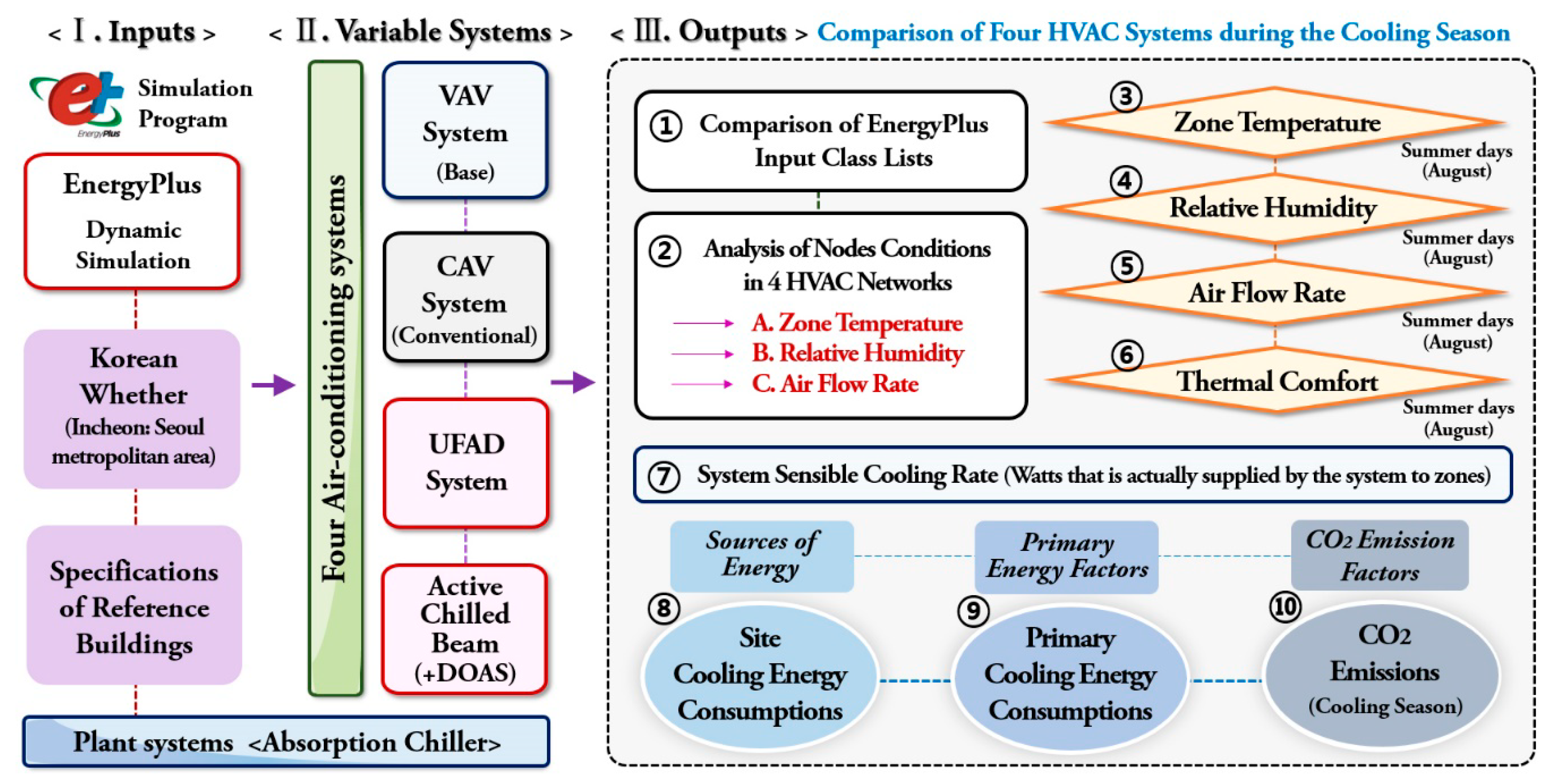
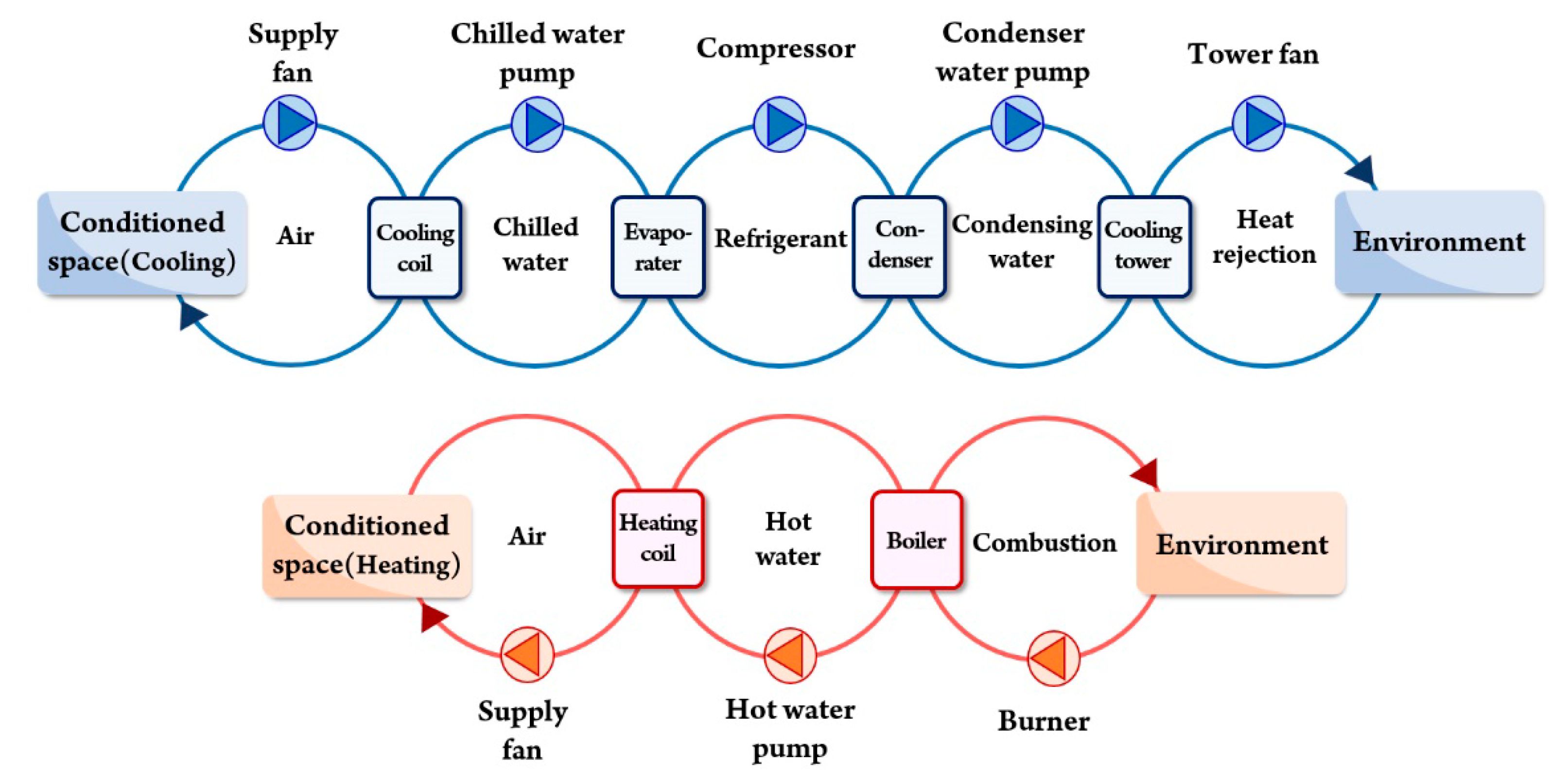
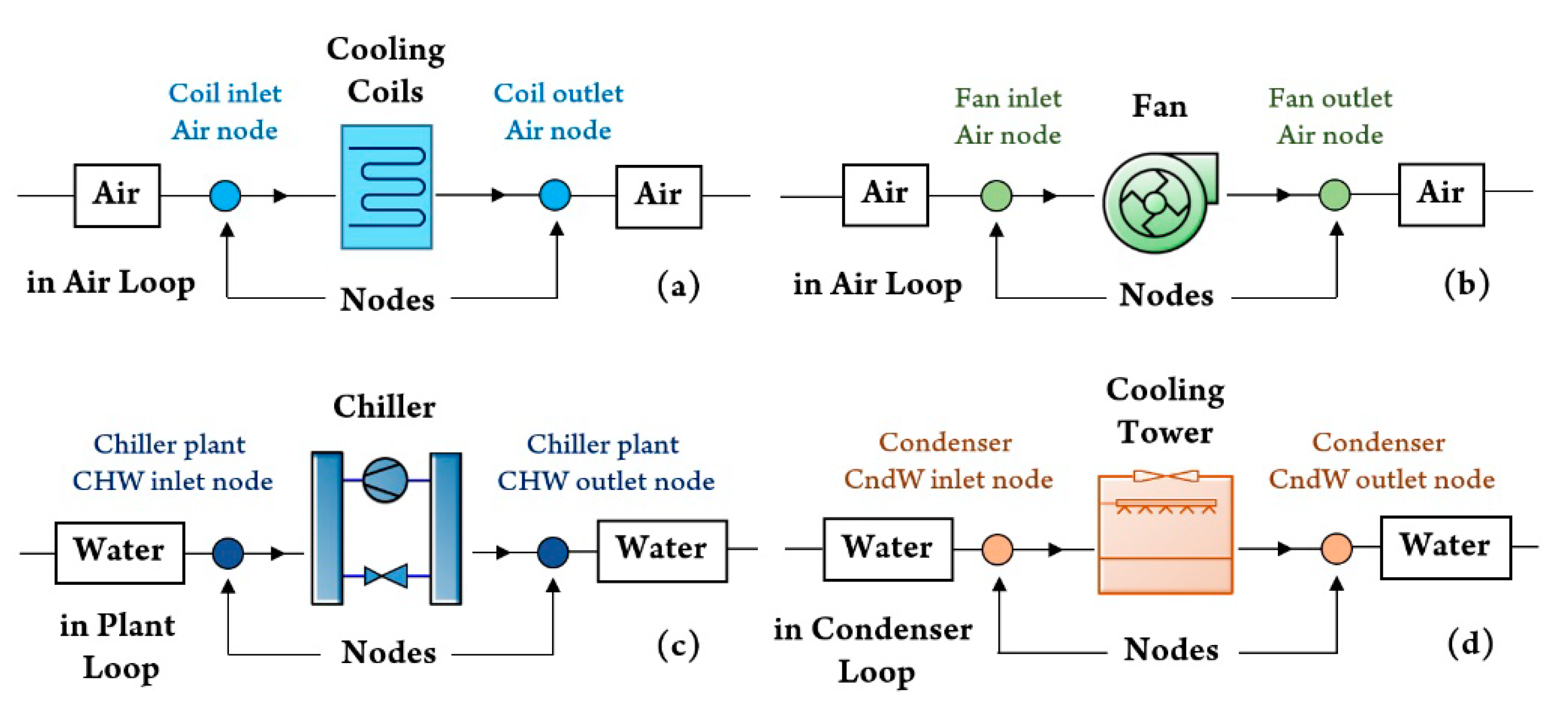
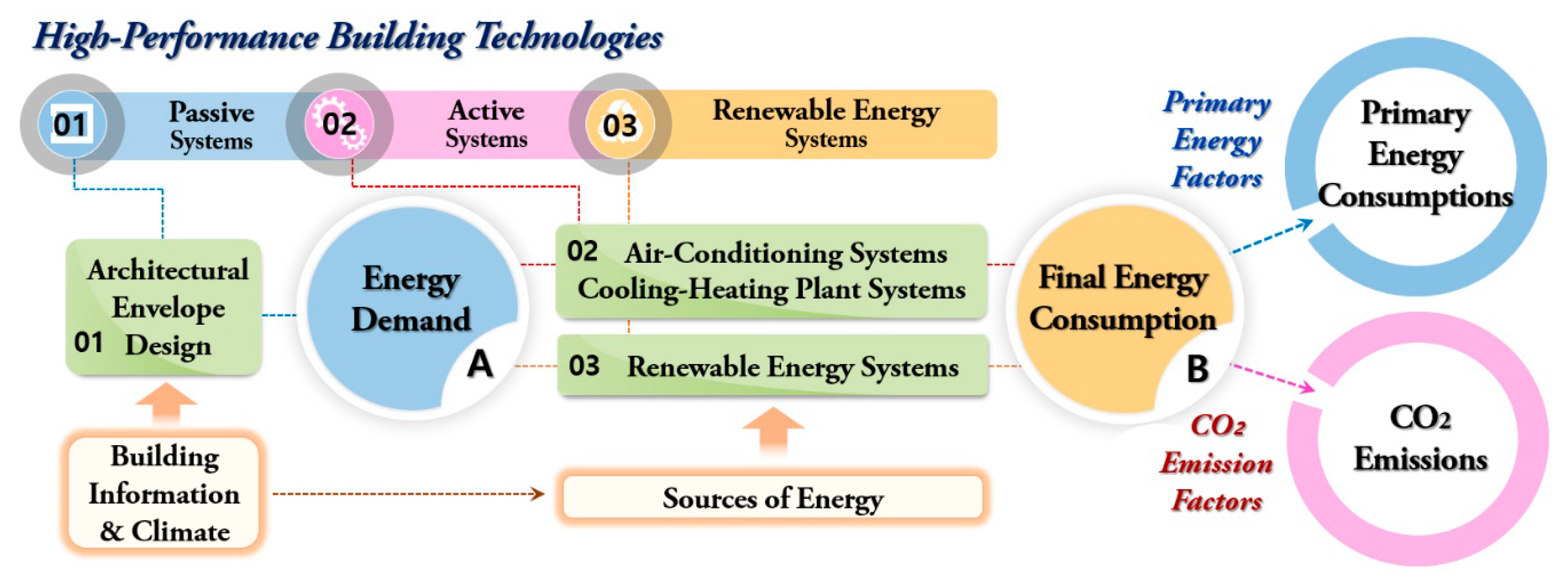
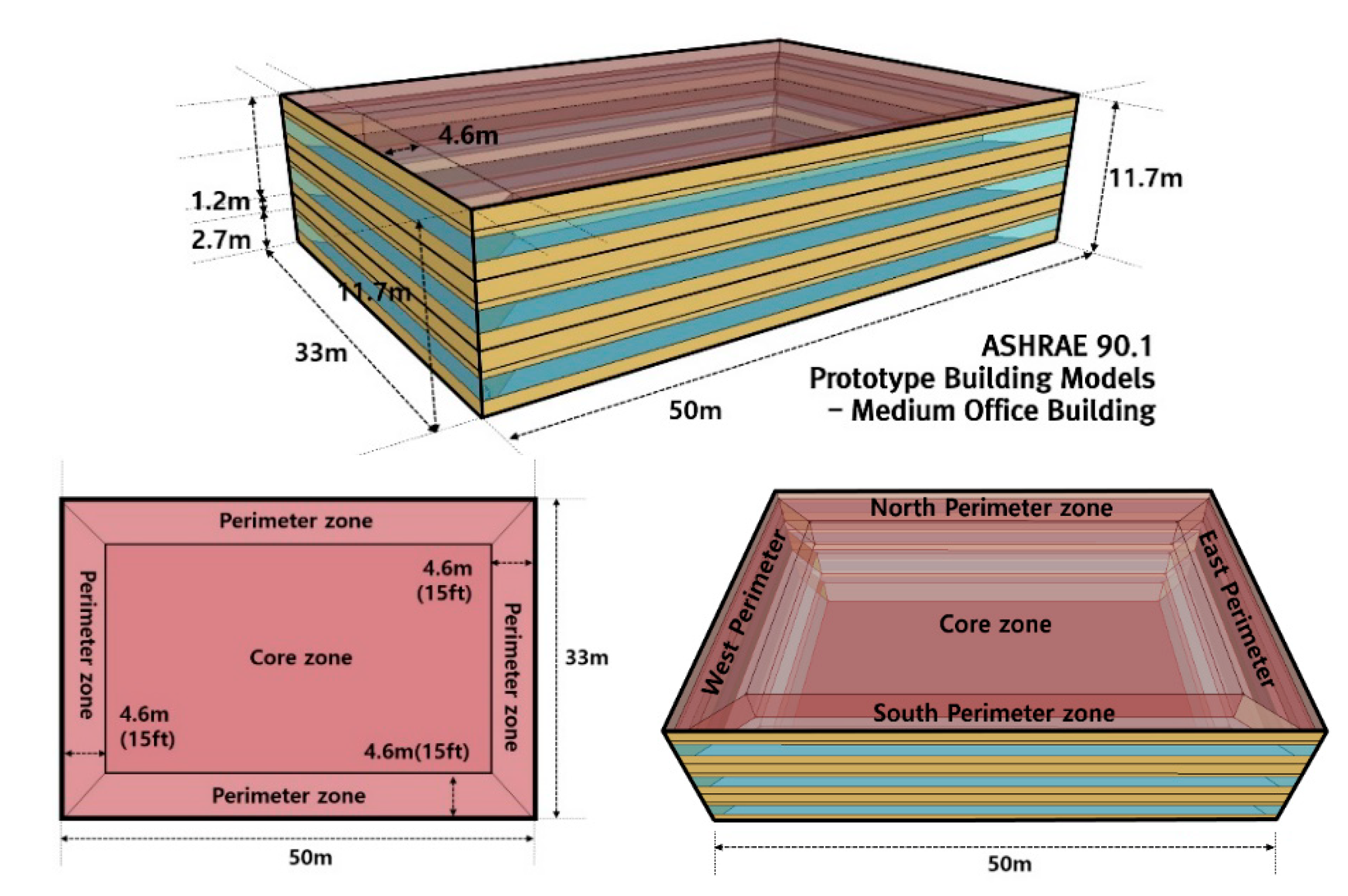
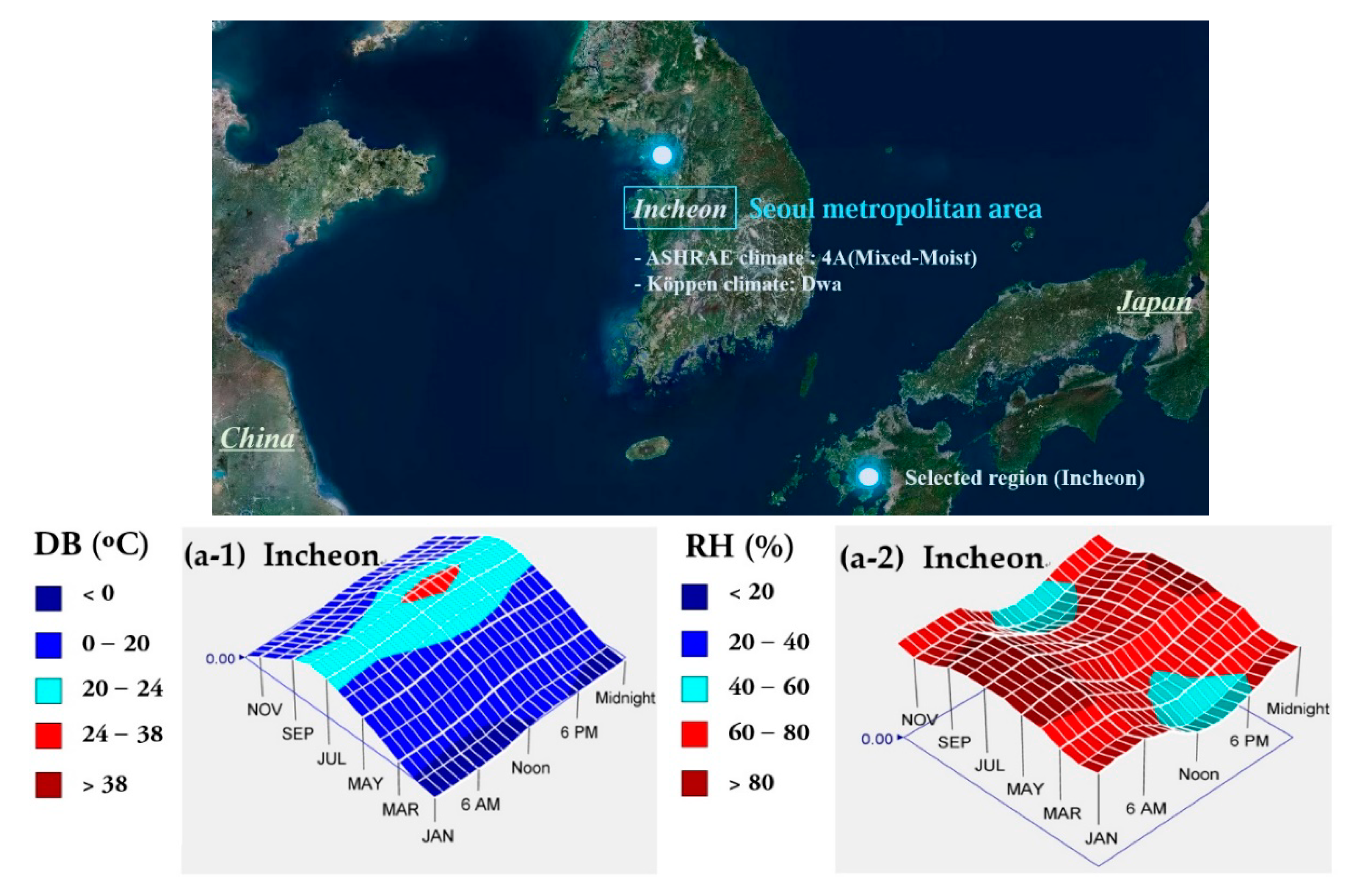
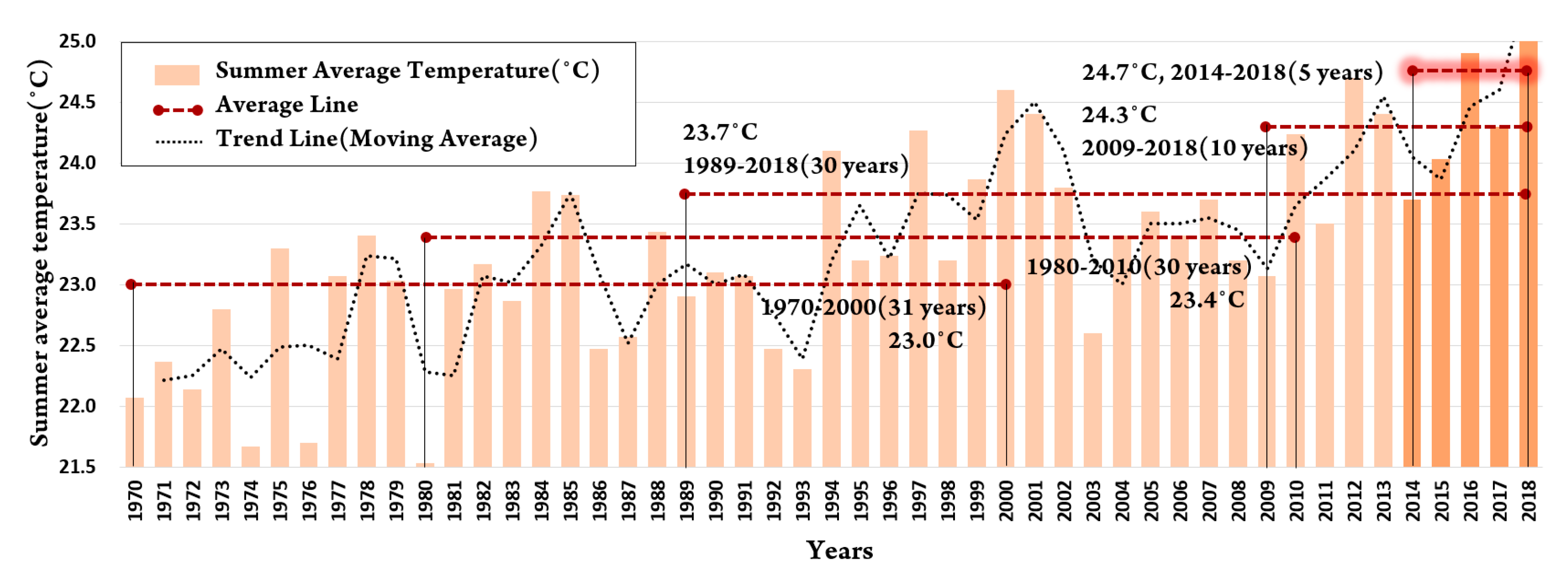

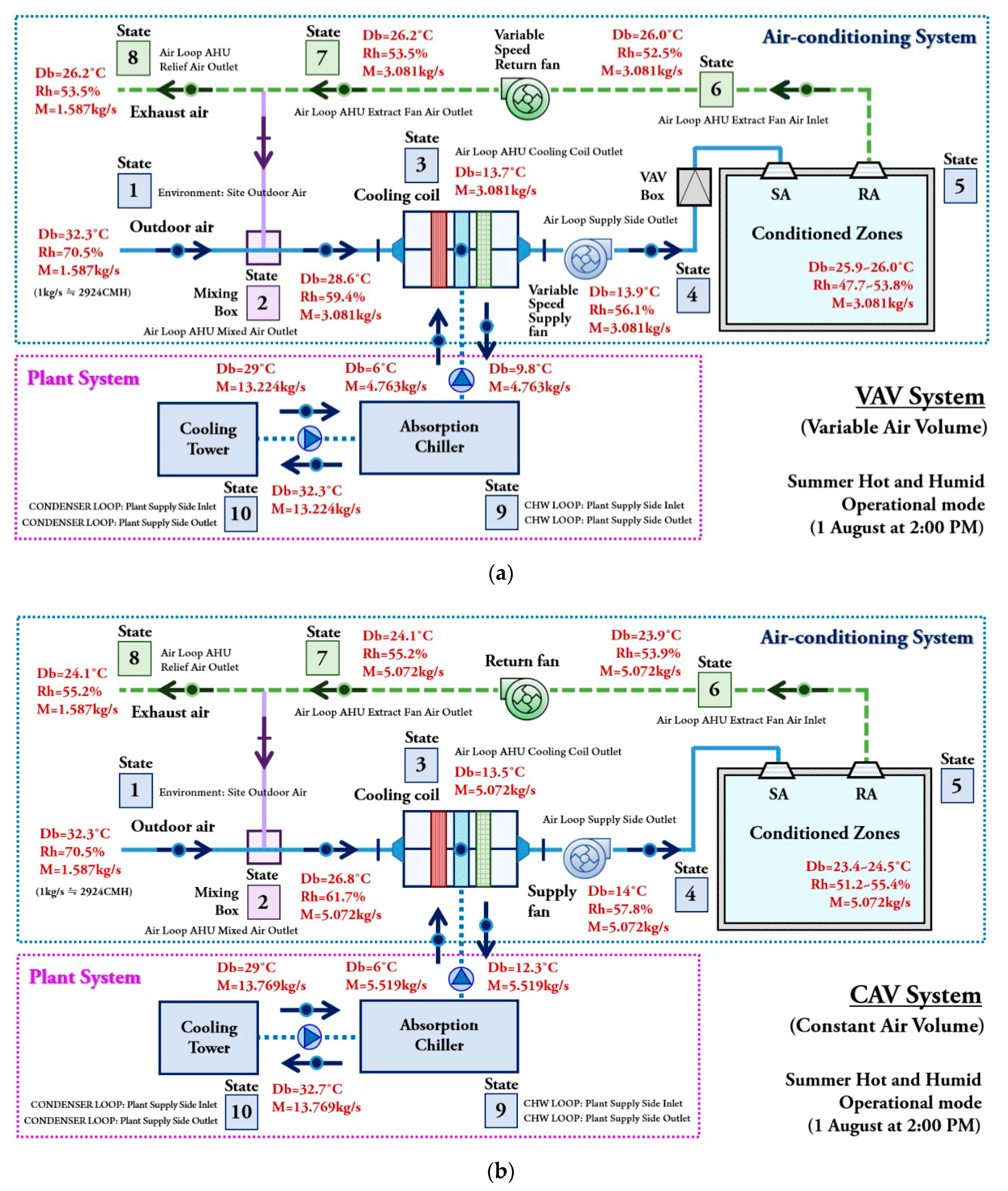
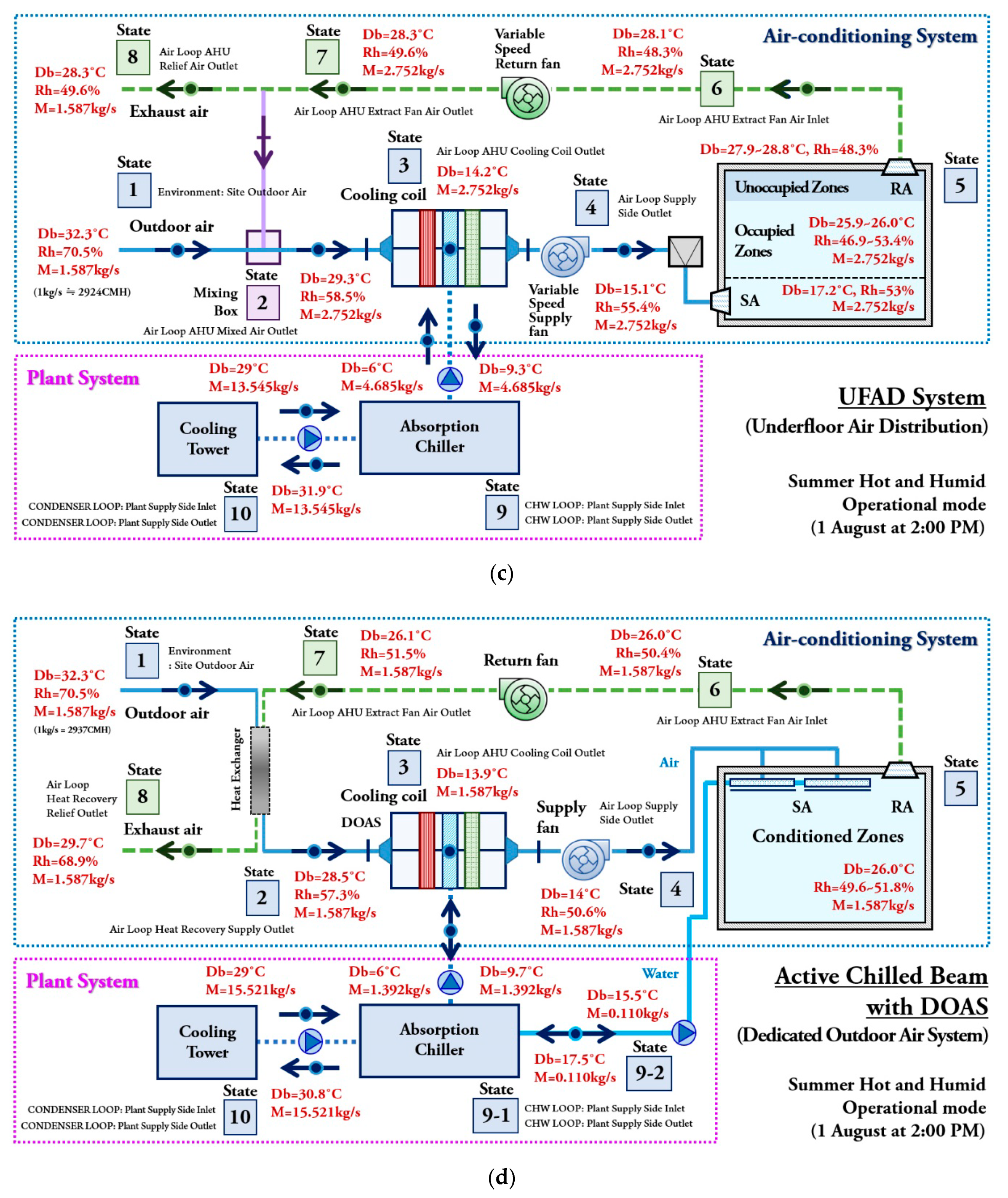
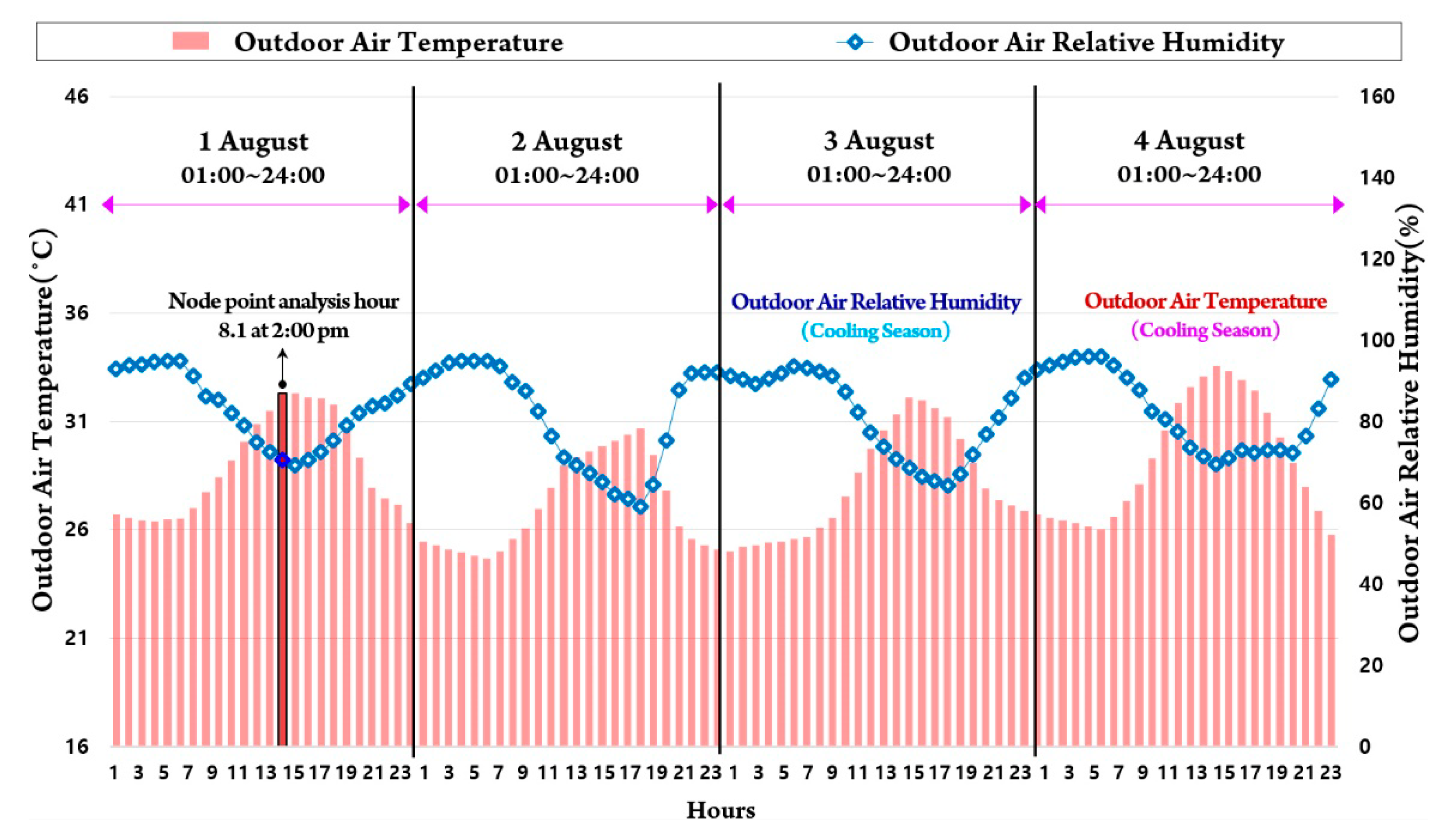
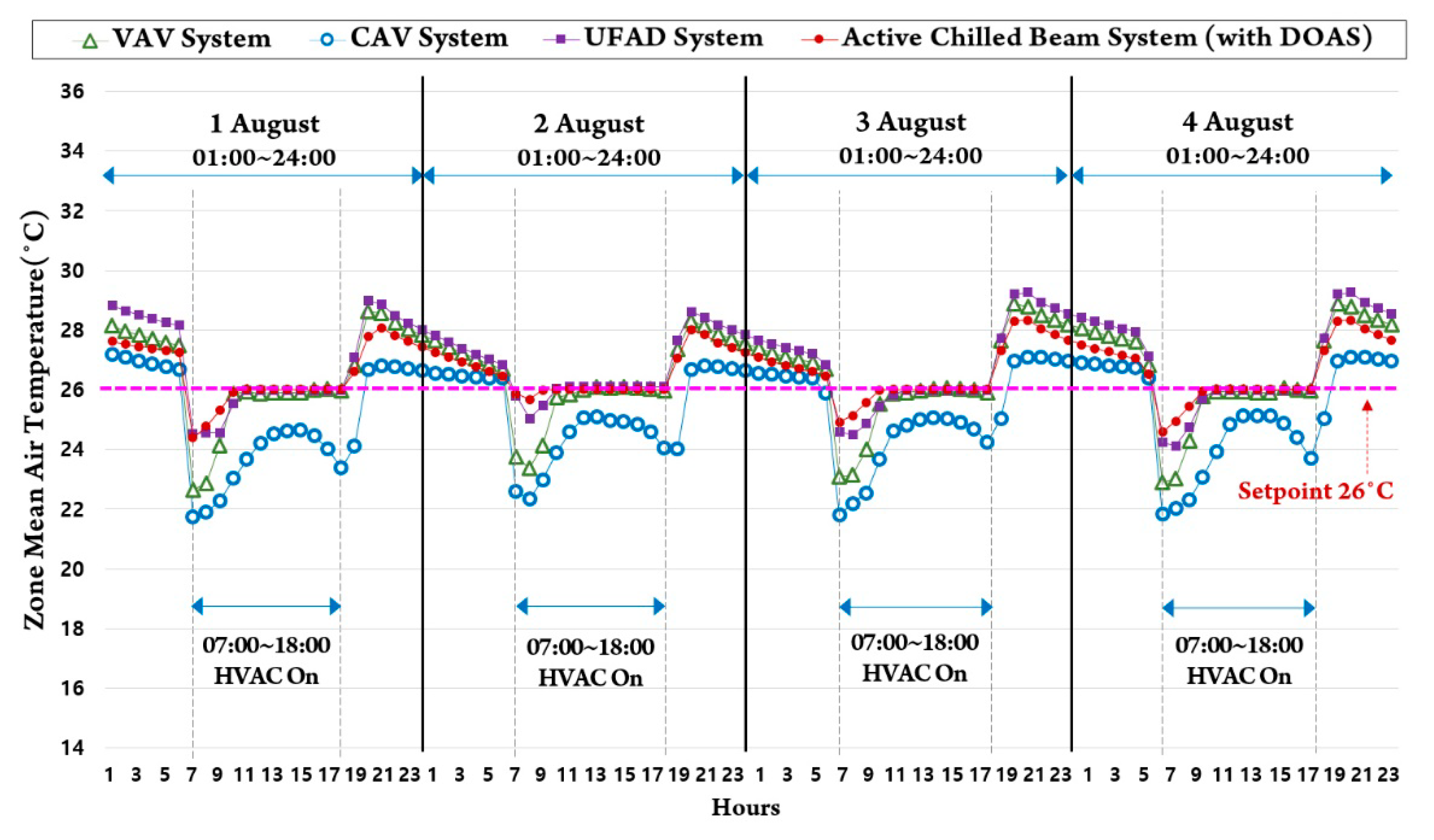
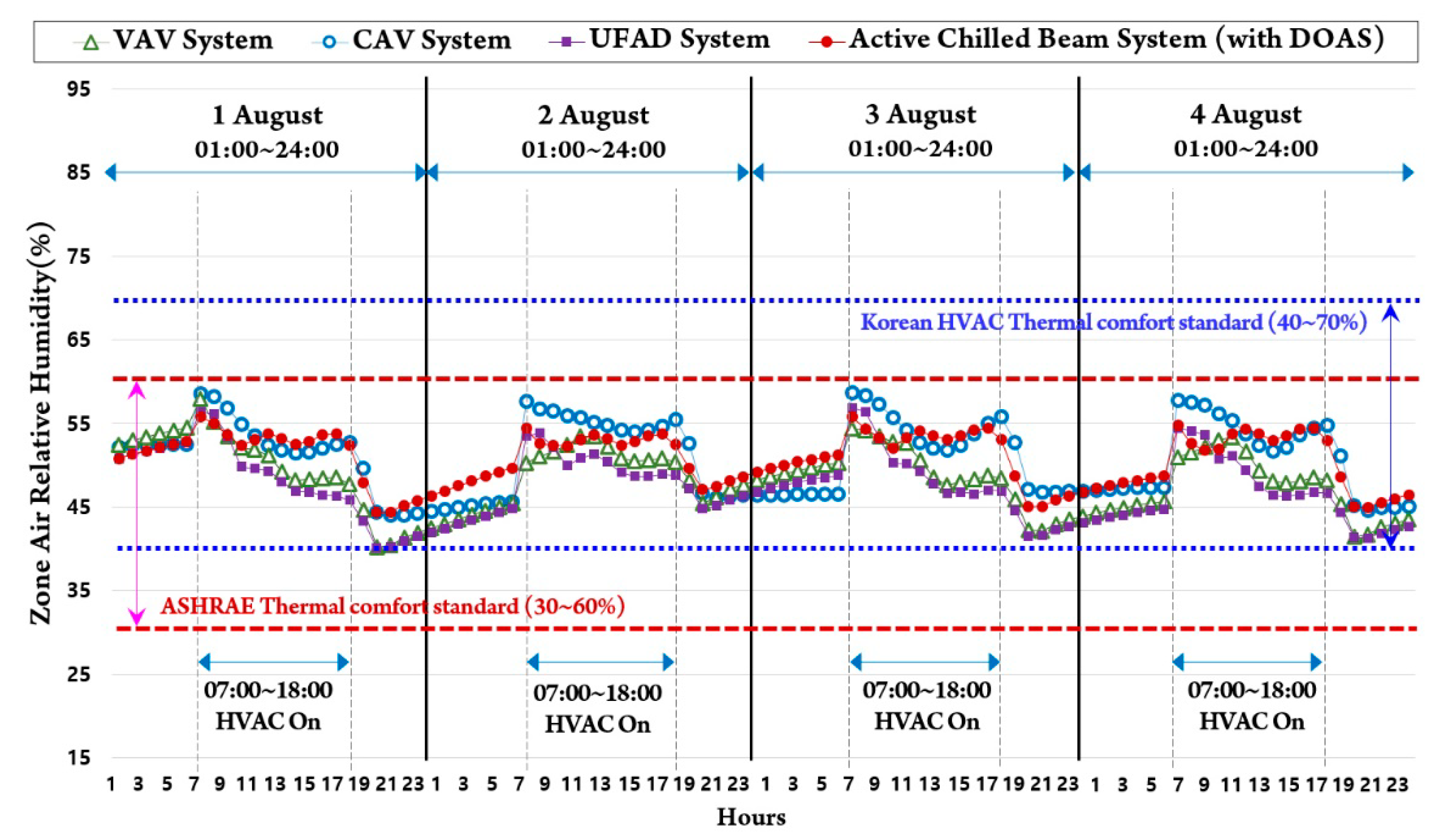

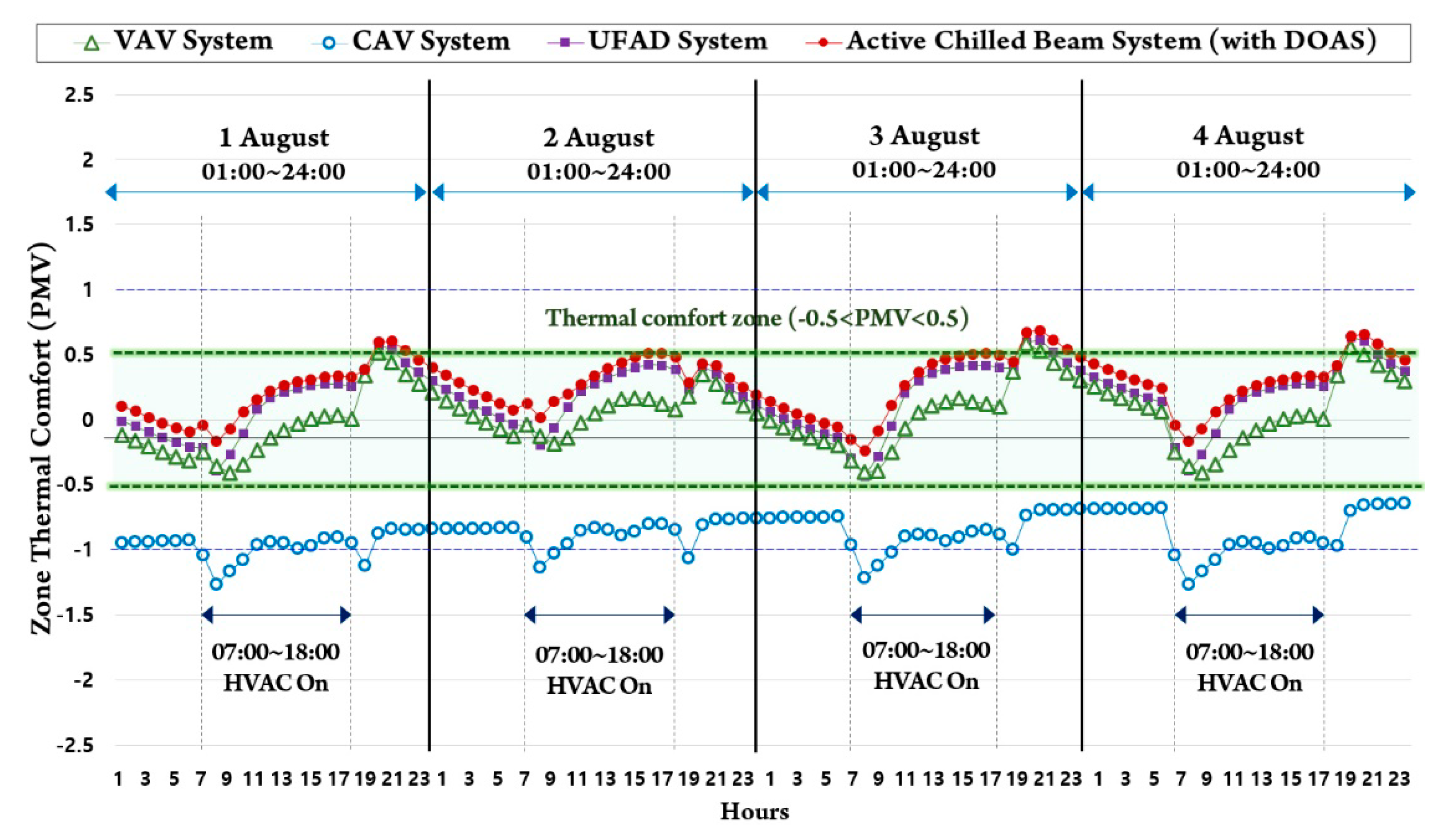



| Energy Supply Sector | Primary Energy Factors in Korea |
|---|---|
| Fuel (Coal, Gas, and Oil) | 1.1 |
| Electricity power | 2.75 |
| District heating | 0.728 |
| District cooling | 0.937 |
| Energy Supply Sector | CO2 Emission Factors (kg CO2/TJ) | CO2 Emission Factors (kg CO2/kWh) |
|---|---|---|
| Electric power | 129,631 | 0.4663 |
| LNG (liquefied natural gas) | 56,467 | 0.2031 |
| Gas/diesel oil | 72,600 | 0.2612 |
| Kerosene | 71,500 | 0.2572 |
| District heating | 34,277 | 0.1233 |
| Division | Specifications of Base Model | |
|---|---|---|
| Usage | Office Building | |
| Floor Area and Direction | 1650 m² (50 m × 33 m × 11.7 m) & South | |
| Simulation Program | EnergyPlus v9.1.0 (dynamic simulation tool) | |
| Base Model Envelope | U-Value of Wall and Doors | Incheon 0.26 W/m2·K and 1.5 W/m2·K |
| (The Korean energy-saving design standards) | ||
| U-Value of Floor | Incheon 0.22 W/m2·K | |
| (The Korean energy-saving design standards) | ||
| U-Value of Roof | Incheon 0.15 W/m2·K | |
| (The Korean energy-saving design standards) | ||
| Glazing Type (Low–E 6T + 12A + 6° CL) | Double Low–E Pane Glazing (U-value = 1.5 W/m2·K, Solar Heat Gain Coefficient (SHGC) = 0.458, VLT = 0.698) | |
| (The Korean energy-saving design standards) | ||
| Base Model System | Terminal Unit | VAV Unit |
| AHU Fan type | Variable Speed Fan | |
| Set point Temp and Relative Humidity | Cooling Temp. 20 °C, Relative Humidity 40–60% | |
| (The Korean energy-saving design standards) | ||
| Cooling Operation Schedule | Cooling Operation (June–August): 07:00–18:00 (26.0 °C) | |
| Plant System | Absorption Chiller (Cooling COP 1.0) | |
| Pump Type & Efficiency | Variable Speed Pump, 0.6 (Design) | |
| Lighting & Equipment Occupancy density | 12 W/m², 11 W/m², 0.1–0.2 person/m² | |
| (The Korean energy–saving design standards, The MOTIE and KICT report) | ||
| Infiltration | 3.0 ACH50 | |
| (The Korean energy-saving design standards) | ||
| Schedule | Weekday: 08:00–18:00, Weekend: Off | |
| (The Korean energy-saving design standards) | ||
| People Metabolic | 117 W/person, 1.1 met (Office Work: Typing) | |
| (ASHRAE Handbook Fundamentals (2009)) | ||
| Clothing Value | 0.5 (Summer) | |
| (ASHRAE Standard 55–2004) | ||
| Air Velocity | 0.1 m/s | |
| (ASHRAE Standard 55–2004) | ||
| Weather Data | Incheon (4A, Dwa), Korea | |
| Regions | ASHRAE Climate | Köppen Climate | Latitude N(°) /Longitude E(°) | Outdoor Air Temperature (Average Monthly) Min./Avg./Max (°C) | Relative Humidity (Average Monthly) Min./Avg./Max (%) | HDD (18 °C) | CDD (10 °C) |
|---|---|---|---|---|---|---|---|
| Incheon | 4A (Mixed–Moist) | Dwa | 37.45/126.70 | −2.4/12.8/27.7 | 46.1/69.1/88.1 | 2749 | 2327 |
| Item | Passive Systems (Envelope) | Active Systems (HVAC) | |||
|---|---|---|---|---|---|
| Wall, Floor, and Roof (U–Value) | Glazing and Solar Shading Systems | Envelope Infiltration | Air Conditioning Systems | Plant Systems | |
| VAV System (Base) | Incheon Standard Wall 0.26 W/m²·K Floor 0.22 W/m²·K Roof 0.15 W/m²·K | Double Low–E (No Blind) (U–Value 1.5 W/m2·K, SHGC 0.458, VLT 0.698) | 3.0 ACH50 | VAV System | Absorption Chiller (Cooling COP 1.0) |
| Terminal Unit: VAV AHU fan type : Variable air volume Control logic : Dual maximum control logic Fan efficiency: 75% (Motor efficiency: 90%) Damper heating action: Reverse Fan pressure : 1100 (SA), 700 Pa(RA) Maximum air flow (Heating) : 50% of max cooling air flow / Minimum air flow: 20% of max cooling air flow | |||||
| CAV System | Incheon Standard Wall 0.26 W/m²·K Floor 0.22 W/m²·K Roof 0.15 W/m²·K | Double Low–E (No Blind) (U–Value 1.5 W/m2·K, SHGC 0.458, VLT 0.698) | 3.0 ACH50 | CAV System | Absorption Chiller (Cooling COP 1.0) |
| Terminal Unit: CAV AHU fan type : Constant air volume Fan efficiency: 75% (Motor efficiency: 90%) Fan Pressure : 1100 (SA), 700 Pa(RA) Constant minimum airflow fraction: 1.0 | |||||
| UFAD System | Incheon Standard Wall 0.26 W/m²·K Floor 0.22 W/m²·K Roof 0.15 W/m²·K | Double Low–E (No Blind) (U–Value 1.5 W/m2·K, SHGC 0.458, VLT 0.698) | 3.0 ACH50 | UFAD System | Absorption Chiller (Cooling COP 1.0) |
| Cooling SAT: 16–18°C Diffuser: Swirl type (Core zone, n=242) Linear bar grille type (Perimeter zone, n=21–24) Fan pressure : 1100 (SA), 700 Pa(RA) Transition height: 1.7m Thermal comfort height: 1.2m Constant minimum airflow fraction: 0.3 | |||||
| Active Chilled Beam with DOAS | Active Chilled Beam with DOAS | ||||
| Chilled beam type: Active Entering water temperature Cooling: 15–17°C Mean coil temperature to room design temperature difference: 2–4°C, Coil surface area per coil length: 5.422m²/m Chilled beam tube inside and outside diameter: 0.0114, 0.0159 Leaving pipe inside diameter: 0.0145m | |||||
© 2019 by the authors. Licensee MDPI, Basel, Switzerland. This article is an open access article distributed under the terms and conditions of the Creative Commons Attribution (CC BY) license (http://creativecommons.org/licenses/by/4.0/).
Share and Cite
Kim, C.-H.; Lee, S.-E.; Lee, K.-H.; Kim, K.-S. Detailed Comparison of the Operational Characteristics of Energy-Conserving HVAC Systems during the Cooling Season. Energies 2019, 12, 4160. https://doi.org/10.3390/en12214160
Kim C-H, Lee S-E, Lee K-H, Kim K-S. Detailed Comparison of the Operational Characteristics of Energy-Conserving HVAC Systems during the Cooling Season. Energies. 2019; 12(21):4160. https://doi.org/10.3390/en12214160
Chicago/Turabian StyleKim, Chul-Ho, Seung-Eon Lee, Kwang-Ho Lee, and Kang-Soo Kim. 2019. "Detailed Comparison of the Operational Characteristics of Energy-Conserving HVAC Systems during the Cooling Season" Energies 12, no. 21: 4160. https://doi.org/10.3390/en12214160
APA StyleKim, C.-H., Lee, S.-E., Lee, K.-H., & Kim, K.-S. (2019). Detailed Comparison of the Operational Characteristics of Energy-Conserving HVAC Systems during the Cooling Season. Energies, 12(21), 4160. https://doi.org/10.3390/en12214160






